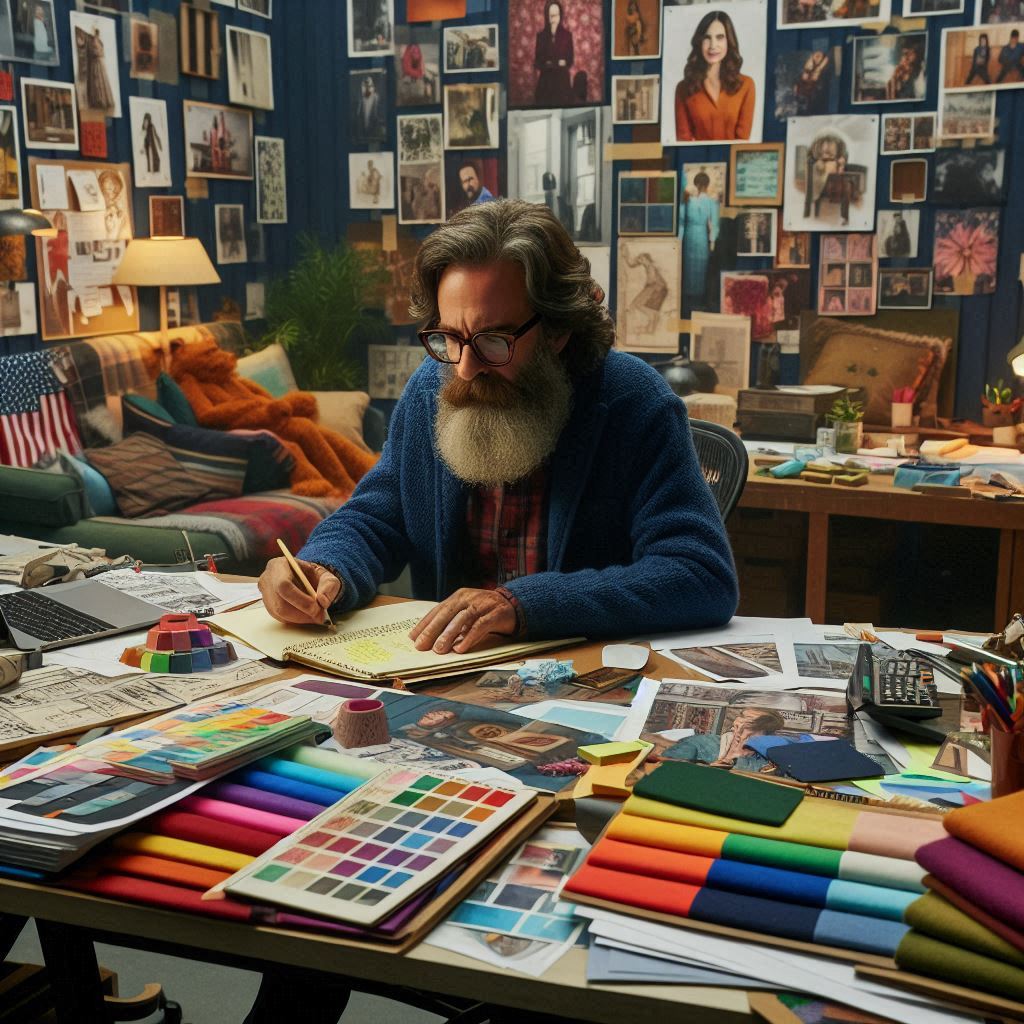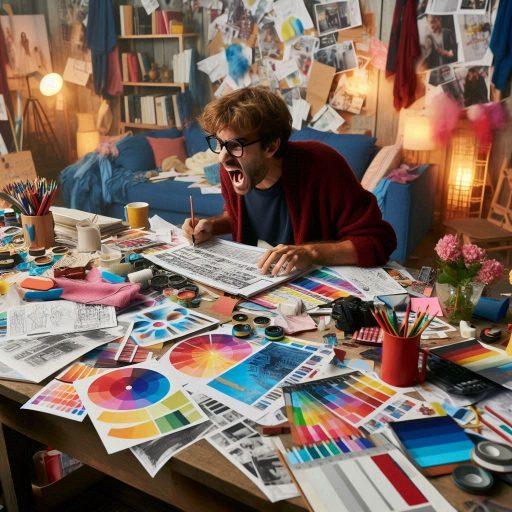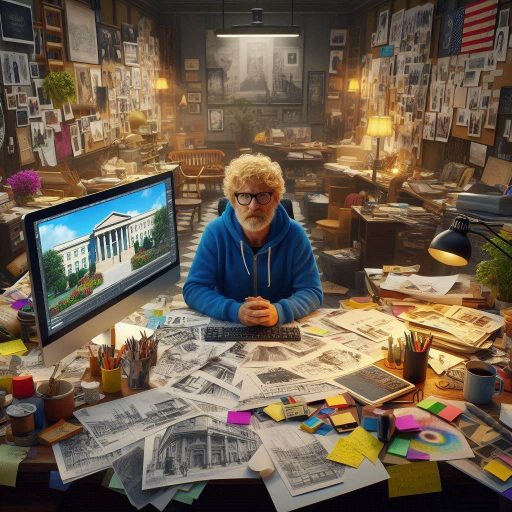Introduction
Production design plays a vital role in various industries, including film, television, theater, and events.
It shapes the visual storytelling and enhances audience engagement through carefully crafted environments.
A strong production design elevates a project’s overall quality and impact, making it essential for creators.
Enrolling in production design courses and programs can significantly benefit aspiring designers.
These programs provide essential skills, including set design, color theory, and visual communication.
Students learn to use industry-standard tools and software, preparing them for real-world challenges.
Additionally, hands-on projects and collaborative experiences help them develop a robust portfolio.
Furthermore, production design courses often offer valuable networking opportunities.
Students can connect with industry professionals, gaining insights and potential job leads.
This exposure is crucial for building a successful career in the field.
The demand for skilled production designers continues to grow in the industry.
As film and television productions expand, the need for creative professionals rises.
Events and theater productions also seek talented designers to create immersive experiences.
Production design is essential across various industries.
Pursuing relevant courses and programs helps individuals sharpen their skills and meet the increasing demand for skilled production designers.
Overview of Production Design
Production Design and Its Role in Creating Visual Elements for a Production
Production design refers to the art of creating visual elements for film, television, and theater.
It encompasses the overall aesthetic and atmosphere of a production.
A production designer translates a script’s narrative into tangible visual experiences.
This role shapes how audiences perceive the story through set design, props, and costumes.
In essence, production design enhances storytelling by establishing mood and context.
The visual elements set the tone for each scene, influencing audience emotions.
A well-designed environment immerses viewers, making the narrative more compelling and believable.
Production designers work closely with directors to develop a cohesive visual vision.
They analyze scripts to identify key themes and emotions.
This analysis helps in crafting an appropriate visual language for the production.
By understanding the story’s essence, production designers create a unified aesthetic that resonates with viewers.
The Key Responsibilities of a Production Designer
Production designers have several key responsibilities in a production.
Their primary duty is creating sets that reflect the script’s vision.
They collaborate with architects and builders to bring their designs to life.
These sets serve as the backdrop for the narrative, providing context and depth.
Another critical responsibility involves designing props that enhance storytelling.
Props are essential elements that characters interact with during scenes.
Production designers ensure that each prop aligns with the production’s overall aesthetic and period.
Costume design is also a significant aspect of a production designer’s role.
They work closely with costume designers to create looks that complement the sets.
Costumes must reflect characters’ personalities and backgrounds, enriching the story.
Additionally, production designers create mood boards and sketches to visualize their ideas.
These tools help communicate their vision to directors and other team members.
Effective communication is vital for aligning everyone with the design direction.
Production designers also manage budgets and resources for their departments.
They ensure that all design elements remain within financial constraints.
This responsibility requires strategic planning and problem-solving skills.
The Collaborative Nature of Production Design with Other Departments
The collaborative nature of production design is essential to a successful production.
Production designers work closely with the cinematography department.
This collaboration ensures that lighting and camera angles complement the set design.
Effective communication between production designers and cinematographers is crucial.
They discuss how colors and textures will impact the overall visual style.
This synergy enhances the storytelling by creating a seamless visual experience.
Art direction is another key area of collaboration.
Production designers work with art directors to execute their vision.
Together, they ensure that all visual elements are cohesive and aligned with the production’s goals.
This teamwork fosters creativity and innovation, resulting in captivating designs.
Sound design is also impacted by production design.
The visual elements of a production can influence sound choices and audio effects.
Production designers often discuss these elements with sound designers to create a unified experience.
Collaboration extends beyond these departments.
Production designers interact with various teams, including special effects and makeup.
Each department contributes to creating a holistic visual narrative.
Production design plays a vital role in shaping the visual elements of a production.
Production designers are responsible for creating sets, props, and costumes that enhance storytelling.
Their collaborative efforts with cinematography, art direction, and other departments are essential for success.
By understanding and embracing this collaborative nature, production designers can create compelling visual experiences that resonate with audiences.
Engaging in top production design courses and programs can prepare aspiring designers for this dynamic and fulfilling career.
Read: Character Design Trends: What’s Hot in 2024?
Benefits of Taking Production Design Courses
The Advantages of Enrolling in a Production Design Course
Enrolling in a production design course offers numerous advantages.
First, students gain hands-on experience in a collaborative environment.
This practical exposure allows them to work on real projects and learn industry standards.
They also benefit from the guidance of experienced instructors who share valuable insights.
These courses often include studio work, where students can experiment with different design techniques.
This experiential learning fosters creativity and confidence.
Students develop their unique design voice while working alongside peers who share similar passions.
Additionally, networking opportunities arise through connections made during the course.
Industry knowledge is another critical advantage.
Students learn about the various aspects of production design, including budgeting, scheduling, and collaboration.
Understanding the entire production process prepares them for the fast-paced environment of film and television.
This comprehensive knowledge is invaluable when entering the industry.
Moreover, production design courses often cover historical and contemporary design trends.
Students explore how these trends influence modern storytelling.
This understanding helps them create relevant and impactful designs that resonate with audiences.
How Courses Can Help Individuals Develop Skills in Drawing, Model-Making, and Computer-Aided Design
Production design courses equip students with essential skills.
Drawing is a fundamental skill that designers must master.
Courses provide instruction on sketching techniques and concept visualization.
Students learn how to communicate their ideas effectively through drawings.
Model-making is another critical skill emphasized in many programs.
Students learn to create physical representations of their designs.
This hands-on practice enhances their understanding of spatial relationships and scale.
Building models allows designers to experiment with materials and textures, bringing their concepts to life.
Computer-aided design (CAD) has become increasingly important in production design.
Many courses incorporate CAD software training, such as AutoCAD or SketchUp.
These skills are essential for creating detailed digital designs and blueprints.
Familiarity with CAD software prepares students for the demands of modern production design.
Courses may cover other digital tools like Adobe Creative Suite.
Proficiency in graphic design software enhances a designer’s ability to create mood boards and presentations.
These skills are vital for communicating ideas to directors and collaborators effectively.
Potential Career Opportunities That Can Arise from Completing a Production Design Program
Completing a production design program opens doors to various career opportunities.
Graduates can pursue roles as production designers in film and television.
They create the visual environment that shapes the story and enhances the audience’s experience.
Many graduates also find success as art directors.
In this role, they oversee the artistic elements of a production and manage the art department.
This position allows them to bring their creative vision to life while leading a team.
Set decorators are another potential career path.
They focus on the details within the set, selecting furniture and decor that align with the production designer’s vision.
This role requires a keen eye for aesthetics and functionality.
Graduates may also work as prop masters, responsible for sourcing and managing props for productions.
This role involves collaboration with various departments to ensure that props enhance the story.
Moreover, some graduates pursue freelance opportunities, allowing for greater flexibility.
They can work on various projects, including commercials, theater productions, and music videos.
This variety keeps the work dynamic and exciting.
Enrolling in a production design course offers significant advantages.
Students gain hands-on experience, industry knowledge, and essential skills like drawing, model-making, and CAD.
Completing a production design program leads to various career opportunities, including production designer, art director, and set decorator.
By pursuing this education, individuals set themselves on a path to success in the exciting world of production design.
Read: How to Price Your Ceramic Artwork
Top Production Design Courses and Programs
List of Reputable Institutions That Offer Production Design Courses
Many reputable institutions offer production design courses worldwide.
These programs equip aspiring designers with the necessary skills and knowledge.
Here is a list of notable institutions:
- California Institute of the Arts (CalArts): CalArts offers a Bachelor of Fine Arts (BFA) in Production Design.
This program focuses on creative thinking and visual storytelling. - University of Southern California (USC) School of Cinematic Arts: USC offers a Bachelor of Arts (BA) in Film and Television Production.
The program includes courses in production design, art direction, and set design. - New York University (NYU) Tisch School of the Arts: NYU offers a Bachelor of Fine Arts (BFA) in Drama.
The program includes a concentration in production design, focusing on set and costume design. - Rhode Island School of Design (RISD): RISD provides a Bachelor of Fine Arts (BFA) in Film/Animation/Video.
This program emphasizes visual design, including production design and art direction. - Savannah College of Art and Design (SCAD): SCAD offers both Bachelor’s and Master’s degrees in Production Design.
The curriculum covers set design, art direction, and scenic design. - London College of Communication (LCC): LCC offers a BA (Hons) in Production Design for Film.
This program focuses on developing creative concepts and practical skills.
The Curriculum and Specialization Options Available in Each Program
The curriculum for production design varies among institutions, offering a range of specialization options.
At CalArts, students explore various design disciplines, including set and costume design.
The program emphasizes collaboration with other disciplines, fostering a comprehensive understanding of production design.
USC’s program combines theory and practical experience.
Students learn art direction, set design, and production management.
The curriculum also includes hands-on projects that simulate real-world scenarios.
NYU’s program provides students with a solid foundation in design principles.
The concentration in production design covers set design, model-making, and costume design.
Students gain practical skills through collaboration with other students in various productions.
RISD focuses on developing artistic skills and technical knowledge.
The curriculum covers production design fundamentals, including set and costume design.
Students also learn about visual storytelling and concept development.
SCAD offers a comprehensive curriculum with a strong emphasis on creativity.
Students can specialize in various areas, such as scenic design and prop design.
The program encourages students to develop their unique design voice.
At LCC, students learn the fundamentals of production design, including model-making and digital design.
The program prepares students for various roles in the industry, including art direction and set decoration.
Notable Alumni or Success Stories Associated with These Courses
Several notable alumni have emerged from these programs, showcasing their success in the industry.
At CalArts, alumni include renowned production designer Rick Carter, who won an Academy Award for his work on Avatar.
USC boasts successful alumni such as Nancy Haigh, an Emmy Award-winning production designer known for her work on Deadwood.
Her achievements highlight the program’s effectiveness in preparing students for industry success.
NYU has produced many successful designers, including Hannah Beachler, who won an Oscar for her production design in Black Panther.
Her innovative designs have made a significant impact in the film industry.
RISD alumni include Peter A.
McKinstry, known for his exceptional work in the film industry.
His experience demonstrates the program’s focus on artistic skill development.
SCAD’s alumni include Matthew D.
McCauley, a production designer recognized for his contributions to television and film.
His career showcases the program’s emphasis on creativity and technical skills.
LCC alumni include Helen Scott, a respected production designer who has worked on numerous successful films.
Her achievements reflect the quality of education provided by the institution.
In fact, numerous reputable institutions offer production design courses.
Each program has its unique curriculum and specialization options, preparing students for successful careers.
Notable alumni from these courses further highlight their effectiveness in nurturing talent in the industry.
Read: Top Skills Needed for a Successful Character Designer

Admission Requirements and Prerequisites
Typical Requirements for Enrollment
Enrolling in a production design course typically requires several key documents.
Most programs ask for a portfolio showcasing your best work.
This portfolio should highlight your design skills, creativity, and attention to detail.
Include a variety of projects, such as set designs, sketches, and digital renderings.
Academic transcripts are also essential for application.
These transcripts demonstrate your previous education and academic performance.
Most programs require a high school diploma or equivalent.
Some may prefer applicants with a background in fine arts or design.
Additionally, you may need to submit letters of recommendation.
These letters should come from teachers, mentors, or industry professionals.
They should speak to your skills, work ethic, and potential in production design.
Strong recommendations can greatly enhance your application.
Some programs may also require a personal statement.
This statement allows you to express your passion for production design.
Discuss your goals and what you hope to achieve through the program.
Overall, meeting these typical requirements is crucial for a successful application.
Prerequisite Skills and Background Knowledge
Before applying, assess whether you have the necessary skills and background knowledge.
Basic drawing and design skills are essential for production design.
Familiarity with design software can also be beneficial.
Many programs teach software skills, but prior knowledge gives you a head start.
Additionally, a background in art, theater, or architecture can be advantageous.
Understanding the principles of design and visual storytelling enhances your readiness for the course.
Exposure to different artistic movements and styles enriches your design perspective.
Moreover, strong communication and teamwork skills are vital.
Production design often involves collaborating with various departments.
Being able to convey ideas effectively is essential for success.
You should also develop time management and organizational skills.
Production designers often juggle multiple projects and deadlines.
Strong organizational abilities help you stay on track and meet expectations.
Tips for Preparing a Strong Application
Preparing a strong application can increase your chances of acceptance into a production design program.
Start by creating a comprehensive portfolio.
Include your best work, showcasing a range of skills and styles.
Aim for quality over quantity; select pieces that represent your unique vision.
Seek feedback on your portfolio from teachers or professionals.
Constructive criticism helps you improve and refine your work.
Make necessary revisions before submitting your application.
Next, focus on your academic transcripts.
If you have room for improvement, consider taking additional courses.
Courses in art, design, or related fields can strengthen your application.
Gather strong letters of recommendation early.
Reach out to individuals who know your work and can speak to your potential.
Provide them with background information about the program and your goals.
This information helps them write a more personalized letter.
Take time to craft a compelling personal statement.
Clearly express your passion for production design.
Discuss why you want to pursue this field and your career aspirations.
Be authentic and reflect your personality in your writing.
Finally, stay organized during the application process.
Create a checklist of requirements and deadlines.
This organization will help you manage your time effectively and ensure you submit all materials on time.
Understanding the typical requirements, necessary skills, and application tips is essential.
By preparing thoroughly and thoughtfully, you can increase your chances of acceptance into a production design program.
Your dedication to showcasing your talents will set you apart from other applicants.
A well-prepared application demonstrates your commitment to your future in production design.
Read: Career Paths in Ceramic Art and Design
Funding and Financial Aid Options
Scholarship Opportunities, Grants, and Loans
Pursuing a production design education can be financially challenging.
Fortunately, many scholarship opportunities exist for aspiring production designers.
Various organizations offer scholarships specifically for students in the arts.
These scholarships can significantly reduce tuition costs and make education more accessible.
Research is key to finding these opportunities.
Many colleges and universities provide their own scholarships for production design students.
I recommend checking the financial aid section of your chosen school’s website.
Additionally, external organizations, such as the Art Directors Guild, offer scholarships for dedicated students.
Grants are another excellent resource for funding your education.
Unlike loans, grants do not require repayment.
Many grants are available based on financial need or academic merit.
Investigate local, state, and national grants tailored to arts education.
Loans can also help finance your production design education.
While loans require repayment, they can cover tuition and living expenses.
Explore federal and private loan options, ensuring you understand interest rates and repayment terms.
Comparing different loan offers helps secure the best financing for your situation.
The Cost of Tuition and Other Expenses
Understanding the costs associated with a production design program is crucial.
Tuition rates vary significantly between institutions.
Public schools often offer lower tuition rates for in-state students.
In contrast, private institutions typically have higher tuition costs.
Beyond tuition, students should anticipate additional expenses.
These may include fees for materials, equipment, and software.
Production design programs often require students to invest in specialized tools and technology.
The costs for these items can add up quickly, so budget accordingly.
Living expenses should also factor into your financial planning.
Consider housing, food, transportation, and personal expenses while attending school.
If you live on campus, additional fees may apply.
Create a detailed budget to ensure you can cover all your costs.
When evaluating programs, consider the overall value.
A higher tuition might offer better resources, networking opportunities, and industry connections.
Research each program’s reputation and alumni success to assess potential return on investment.
Information on How to Apply for Financial Aid
Navigating the financial aid process can be overwhelming but is essential for funding your education.
Start by completing the Free Application for Federal Student Aid (FAFSA).
This application assesses your financial need and determines eligibility for federal aid.
Many states and institutions also require separate financial aid applications.
Research specific requirements for your chosen school to avoid missing deadlines.
After submitting your FAFSA, review your student aid report (SAR) for accuracy.
This report summarizes your financial situation and eligibility for aid.
Explore additional scholarships and grants after applying for federal aid.
Many organizations require separate applications, so be diligent in your search.
Prepare materials such as transcripts, letters of recommendation, and personal statements.
Tailor your application to highlight your passion for production design.
When considering loans, understand the types available.
Federal student loans typically offer lower interest rates and better repayment options.
Research private loans as well, but compare interest rates and terms carefully.
Consult your school’s financial aid office for guidance on securing loans.
Finally, maintain organized records of all financial documents.
Keep track of applications, deadlines, and correspondence with funding organizations.
Staying organized streamlines the process and helps you meet crucial deadlines.
Pursuing a production design education requires careful financial planning.
Explore scholarship opportunities, grants, and loans to fund your studies.
Understanding the costs associated with production design programs is vital.
By applying for financial aid and staying organized, you can navigate the funding process effectively.
This preparation ensures you can focus on your education and achieve your production design goals.
Transform Your Career Today
Unlock a personalized career strategy that drives real results. Get tailored advice and a roadmap designed just for you.
Start NowIndustry Networking and Internship Opportunities
The Importance of Networking in the Production Design Field
Networking plays a crucial role in the production design field.
Building connections with industry professionals opens doors to new opportunities.
These relationships can lead to internships, jobs, and collaborations.
Networking helps you learn from experienced designers and gain valuable insights.
Attend industry events, workshops, and film festivals.
These gatherings allow you to meet professionals in a relaxed atmosphere.
Engaging in conversations can spark connections that lead to mentorship or job offers.
Don’t hesitate to introduce yourself and express your passion for production design.
Utilize social media platforms to connect with industry experts.
Platforms like LinkedIn and Instagram are great for showcasing your work.
Follow and engage with production designers, directors, and other creatives.
Share your projects and participate in discussions to gain visibility.
Join professional organizations or associations related to production design.
These groups often provide valuable resources and networking opportunities.
Membership can grant access to exclusive events and workshops.
Being part of such communities enhances your credibility in the field.
The Benefits of Participating in Internships or Apprenticeships
Internships and apprenticeships provide invaluable practical experience in production design.
These opportunities allow you to apply classroom knowledge in real-world settings.
Working alongside professionals helps you understand industry standards and practices.
Participating in internships helps you build a strong portfolio.
A well-rounded portfolio showcases your skills and creativity.
Include projects from your internships to demonstrate your ability to work on diverse designs.
A robust portfolio increases your chances of landing future jobs.
Internships also help you develop essential soft skills.
You learn to communicate effectively and collaborate with different departments.
Time management becomes crucial as you juggle multiple tasks.
These skills are vital for success in the fast-paced production environment.
Moreover, internships often lead to job opportunities.
Many companies hire interns who demonstrate talent and dedication.
By proving your worth during an internship, you can secure a full-time position.
Building relationships with your mentors increases your chances of being recommended for future roles.
Tips for Securing Internships and Maximizing Networking Opportunities
To secure internships, research companies and studios that align with your interests.
Create a targeted list of potential places to apply.
Tailor your resume and cover letter for each application.
Highlight relevant skills and experiences that make you an ideal candidate.
Leverage your school’s career services.
Many programs have connections with industry professionals and can help you find internships.
Attend career fairs and workshops to meet potential employers.
These events provide excellent opportunities to showcase your skills.
When networking, approach professionals with genuine curiosity.
Ask questions about their experiences and seek advice.
Show enthusiasm for their work and express your desire to learn.
Building rapport can lead to mentorship opportunities or job leads.
Once you secure an internship, make the most of it.
Be proactive and eager to learn from your supervisors.
Take on additional responsibilities when possible.
Show initiative by contributing ideas and solutions during projects.
Keep a record of your accomplishments during your internship.
Document your contributions and the skills you developed.
This information will be helpful for future job applications and interviews.
Share your experiences on social media and professional platforms to increase your visibility.
Finally, maintain relationships with your network after completing your program.
Follow up with connections you made during internships and events.
Send thank-you notes to mentors and professionals who helped you.
Staying in touch can lead to future opportunities and collaborations.
In summary, networking is essential in the production design field.
Establishing connections with industry professionals can lead to valuable opportunities.
Participating in internships or apprenticeships provides practical experience and builds a portfolio.
By following these tips, you can secure internships and maximize networking opportunities effectively.
Specialization and Career Paths in Production Design
Specializations Within the Production Design Field
Production design encompasses various specializations, each offering unique creative opportunities.
Set design is one of the most well-known fields.
Set designers create immersive environments that transport audiences into the story.
They collaborate closely with directors and cinematographers to achieve the desired aesthetic.
Prop styling is another essential specialization.
Prop stylists curate and design objects that enhance the narrative.
They select items that reflect the characters and themes.
These professionals pay attention to detail to ensure authenticity.
Visual effects (VFX) is a growing area within production design.
VFX artists create digital elements that blend seamlessly with live-action footage.
They help bring fantastical worlds and concepts to life.
Knowledge of both design and technology is crucial in this field.
These specializations allow production designers to find their niche.
Each path offers different challenges and creative outlets.
By exploring these areas, students can tailor their education to match their interests.
Career Paths for Graduates of Production Design Programs
Graduates of production design programs have numerous career opportunities.
Many find positions in film and television studios.
These professionals work on diverse projects, from indie films to major blockbusters.
Their work contributes significantly to the overall look and feel of each production.
Event production companies also seek skilled production designers.
These designers create visually stunning experiences for concerts, exhibitions, and corporate events.
They understand how to engage audiences through thoughtful design and staging.
Theater productions present another avenue for graduates.
Production designers in theater focus on creating sets that enhance live performances.
They collaborate closely with directors and actors to convey the story effectively.
Additionally, some graduates may choose to work freelance.
This path offers flexibility and the chance to collaborate on various projects.
Freelancers can build a diverse portfolio that showcases their skills across multiple formats.
Growing Demand for Production Designers in Emerging Industries
The demand for production designers continues to grow in emerging industries.
Virtual reality (VR) is one area experiencing rapid expansion.
VR creators need skilled designers to craft immersive environments.
Production designers help build worlds that engage users in interactive experiences.
Interactive media, such as video games, also requires talented production designers.
These professionals work to develop engaging visuals that captivate players.
They create environments, characters, and objects that enhance the gameplay experience.
Furthermore, as technology advances, opportunities in augmented reality (AR) are increasing.
Production designers play a key role in merging physical and digital worlds.
They design experiences that blur the lines between reality and virtuality.
The growing demand for skilled production designers reflects industry trends.
As visual storytelling becomes more prominent, designers will continue to be essential.
Their expertise helps shape the future of entertainment and media.
Production design offers diverse specializations and career paths.
Graduates can work in film, television, theater, or event production.
The rising demand in emerging industries like VR and interactive media further highlights this field’s importance.
Students in production design programs can expect exciting opportunities in an evolving landscape.
By honing their skills and exploring various specializations, they can shape the future of visual storytelling.
Conclusion
Production design courses are essential for developing skills and knowledge in this dynamic industry.
They provide aspiring designers with a strong foundation in artistic principles and technical expertise.
Understanding the intricacies of set design, color theory, and spatial awareness is crucial for success.
Many universities and institutions offer specialized programs in production design.
These courses often include hands-on projects that allow students to apply their learning.
Researching various programs helps aspiring designers find the best fit for their personal and professional goals.
In addition to formal education, continuous learning is vital in production design.
The industry evolves rapidly, with new technologies and trends emerging regularly.
Staying current through workshops, online courses, and industry events enhances your skills and adaptability.
Networking opportunities within these programs can lead to valuable connections in the industry.
Collaborating with peers and professionals fosters growth and inspires creativity.
Aspiring production designers should take their education seriously.
Seek out programs that challenge you and align with your aspirations.
Embrace continuous learning as a lifelong journey, and always strive for improvement.
By investing in your education and development, you position yourself for a successful and fulfilling career in production design.
[E-Books for Sale]
The Big Book of 500 High-Paying Jobs in America: Unlock Your Earning Potential
$19.99 • 500 High-Paying Jobs • 330 pages
Explore 500 high-paying jobs in America and learn how to boost your career, earn more, and achieve success!
See All 500 High-Paying Jobs of this E-Book
1001 Professions Without a Degree: High-Paying American Jobs You Can Start Now
$19.99 • 1001 Professions Without a Degree • 174 pages
Discover 1001 high-paying jobs without a degree! Unlock career tips, skills, and success strategies for just $19.99!




